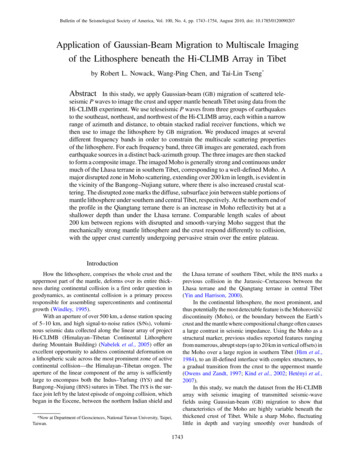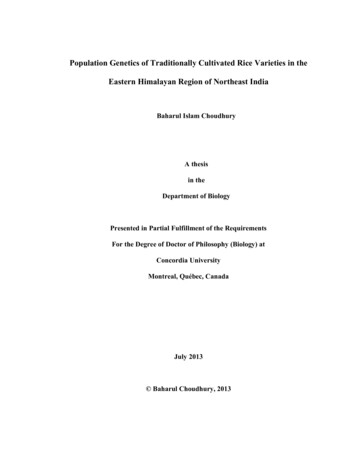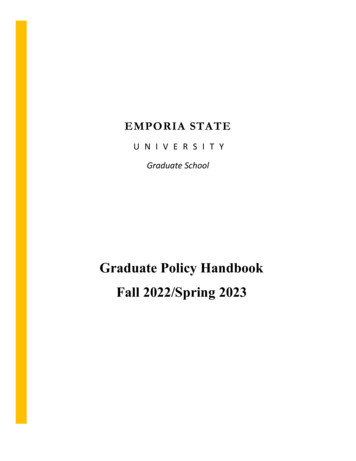
Transcription
Apprenticed to a himalayan master a yogi s autobiography pdf online download
Forthcoming Titles from Magenta Press Mountains, Planes, Barren Deserts, and What Lies Beyond -- The Journey Continues. by Sri M, Author of Apprenticed to a Himalayan Master: A Yogi's Autobiography. How to Levitate and Other Secrets of Magic by James Talbot Wisdom of the Great Sages: Conversations with Sri Guru, Babaji and OtherMasters Other Titles by Sri M The Little Guide to Greater Glory and a Happier Life, published by Hima Communication Wisdom of the Rishis: The Three Upanishads: Ishavasya - Kena - Mandukya, published by Satsang Communications New edition of Jewel in the Lotus: Deeper Aspects of Hinduism, published by Magenta Press The author, 2010 Allrights reserved. No part of this publication may be reproduced, stored in retrieval system or transmitted by any means, electronic, photocopying, recording, or otherwise, without the prior written permission of the copyright holders. eISBN: 978-93-82585-86-2 First printed December 2010 Fourth impression November 2011 Front cover photo: NareshRaman Book design: J. Menon. www.grantha.com Typeset at PACE systems & graphic communications, Chennai. Printed at Saibond Print Systems, Chennai. Published by Magenta Press and Publication Pvt Ltd., Cauvery Towers, College Road-Madikeri, Kodagu, Karnataka 571201. Tel: 91 9845831683. www.magentapress.in Contents Title PageCopyright & Permissions Acknowledgements Foreword List of Photo Inserts 1. The Beginning 2. A Visit from the Himalayan Master 3. The Gayatri Mantra 4. Meeting Yogi Gopala Saami 5. A God-Intoxicated Sufi 6. Inside the Subramanya Temple 7. Preparing for the Ascent 8. The Story of Sri Narayana Guru 9. Strange and Timely Inputs 10. TheMastan’s Blessings 11. Three Monks 12. Mai Ma 13. Understanding Holy Madness 14. Trial Run 15. Towards the Himalayas 16. The Cave of Vasishta 17. The Naga and Learning the Mahamantra 18. The Cobbler and the Monk 19. The Seeker at Badrinath 20. Meeting Babaji 21. My First Initiation 22. Lighting the Kundalini Fire 23. The Old TibetanLama 24. Yoga, Vedanta, and the Nath Pant 25. Tholingmutt and the Mountain Man 26. The Valley of Flowers and Hemkund 27. Meeting the Siddhar 28. Kedarnath: Opening the Channels 29. The Fireball from the Sky 30. The Healing and Meeting the Grand Master 31. A Truly Holy Man 32. Sri Vidya Initiation 33. Lessons from the German 34. GoingBack to Trivandrum 35. Preparations for the Mission 36. Lessons from a Sufi Master 37. The Ramakrishna Mission 38. Sri Devi and Neem Karoli Baba 39. The Aghori from Banaras 40. Alandi, Shirdi and Walking Through Doors 41. More Travels: New Insights 42. Babaji at the Taj Mumbai 43. Meeting Laxman Joo and J. Krishnamurti 44. Vasant Vihar45. Babaji Leaves His Body 46. The Passing Away of ‘K’ 47. Marriage and Shifting to Neel Bagh 48. Neel Bagh and the Satsang Train 49. The Kailash-Manasarovar Yatra 50. The Journey Continues Reviews About the Author About the Book Backcover List of Photo Inserts 1. 2. 3. 4. 5. 6. 7. 8. 9. 10. 11. 12. 13. 14. 15. 16. 17. 18. 19. 20. 21. 22. 23. 24.25. 26. 27. 28. 29. 30. 31. My maternal grandmother My father and mother My two sisters At six months At 3 years of age Reading Aristotle at 16 House in Vanchiyoor where I lived till the age of 14 Padmanabha Swamy temple and the sacred pond My school – Government Model High School, Thycaud Tomb of Peer Mohammed Sahib, TuckaleySunanda and I just before marriage With family at Tunganath With Sunanda, her parents, brother and our children Badrinath Temple Kedarnath Temple Sri Gopala Saami Sri Kaladi Mastan Poonthura Swamy Sri Narayana Guru Swami Abhedananda Sai Baba of Shirdi Sri Chattambi Swami Nityananda Avadhoota of Ganespuri at a young age Mai Ma,saint of Kanyakumari Sri Ramkrishna Paramahansa Swami Vivekananda as on itinerant monk Ramana Maharishi with a good friend Sri Shyama Charan Lahiri, the great yogi, disciple of Sri Guru Babaji Swami Tapasyananda, senior monk of the Ramakrishna order Neem Karoli Baba of Kainchi, Almora Sri Jidoo Krishnamurti 32. 33. 34. 35. 36. 37. 38.39. 40. 41. 42. 43. 44. 45. 46. 47. 48. 49. 50. 51. 52. 53. 54. 55. 56. 57. 58. 59. 60. 61. 62. 63. 64. 65. 66. Swami Chidananda of the Divine Life Society, Rishikesh Snow clad Kedar range Arundhati cave near Vasishta Guha Cave at Maruthuvamalai, near Kanyakumari River Ganga near Chirbasa At Charan Paduka behind Badrinath temple Gomukh,birthplace of the river Ganga Seashore at Kanyakumari where Mai Ma lived Sri Maheshwarnath's Guru, Sri Guru Babaji My Guru, Sri Maheshwarnath Babaji In Ardhamatsyendrasana at Rishikesh River Ganga in Rishikesh At the Grand Canyon: first visit to the USA Painting for a friend in Germany At a café near Frieburg Cathedral, GermanyBhagirathi peaks River Ganga descends at Suryakund, Gangotri Satsang at Vyasa Guha, Mana beyond Badrinath Neel Bagh School, Rayalpad With my dear classmates in Trivandrum Vivek Mahendru from Delhi, an early acquaintance With my dear friends Sri Ramaswamy Pillai and neurologist Dr. Marthanda Pillai With Hans Kelichhaus in Achen,Germany With friend Jerry Jones in Portland, USA With my friends, Dr. V S Ramachandran, Neurologist and Sitaram Naidu Talk at Bharatiya Vidya Bhavan, Banglore Talk at Portland, USA With Joseph Mar Ireneus, presently Joseph Mar Thoma, the Metropolitan of the Mar Thoma Syrian Church, at the United Nations Conference of religious leaders,New York, 2000 With head of the Brahmakumaris at the United Nations Conference of religious leaders Sunanda and I with the then President of India, Dr. A P J Abdul Kalam, Justice Venkatachalaiah, and Dr. Ajay Kumar Singh, at the Peepal Grove School, Sadum With students of the Satsang Vidyalaya at its inception With dear friends at myresidence, Madanapalle With Head Mistress and students of Satsang Vidyalaya Trip to Kailash: At Yama Dwar (entrance to the Kailash Parikrama) At the lake near Peepal Grove School, Sadum 67. 68. 69. 70. 71. 72. 73. 74. 75. 76. 77. 78. 79. 80. 81. 82. At the retreat in the Peepal Grove School Trip to Kailash: Gurupoornima at Paryang Trip toKailash: The Kargyupa Buddhist Monastery at Horchu The Golden temple Amritsar View of the Holy Kailash mountain The Taj Mahal Hotel, Mumbai where Babaji appeared as a Sikh With His Highness Marthanda Varma of Travancore at the talks in Trivandrum With Sri Krishnadas Ji With Dr. Karan Singh at his residence With the sadhu samaj at thePurna Kumbh Mela, Haridwar, 2010 Meditation Hall at my residence, Madanapalle With dear friends, Brigadier Narayan, Dr. Ajai Kumar Singh, IPS, and Sri. Achyut Rao, IPS With dear friends in Satsang Vidyalaya, Madanapalle With dear friends: Kathyayini Ratan and Deepak Ratan With Federico Grandi at the release of Jewel in the Lotus in Spanishat Buenos Aires, Argentina Nayana Swami Acknowledgements I express my deep sense of gratitude to the following friends without whose help this book would not have been possible. To Kaizer Karachiwala, who painstakingly and with great care made sense of my often unclear scribbling and turned them into a readable manuscript. To Balaji andSreedhar, who from the start, took charge of publishing and business aspects so selflessly and efficiently. To Shobha Reddy, who from the beginning took upon herself the responsibility of photographs and building up a formidable photo-archives in spite of my reluctance to approve the enterprise, and who with great attention and dedication helpedme sort out the pictures that you’ll find in here. To Roshan, my son, and friend, Radha Mahendru, who specially helped in selecting the photographs and working out the layout of the pictures. To Vijay Bhasker, who looked after the office work. And to all my dear friends, whose great longing to know the hitherto secret and unknown chapters of my lifemoved me to begin this book in the first place. Thank you one and all. Sri M. Foreword Before I take you with me on this adventurous journey, from the southern coast of India to the snowy heights of the mystical Himalayas and back, meeting extraordinary individuals, and sharing unusual and incredible experiences, I would like to say a few wordswhich will put everything in its proper perspective. Until now, I have held most of the experiences I have written about in this book, close to my heart, not letting even my closest friends, persuade me to come out with anything more than a hint of what lay hidden in the depths of my consciousness. Why was I so secretive in these matters, and whyhave I now spilled the beans, as the expression goes? Let me answer these questions now: My Master Babaji, although he had hinted that I would at some point, write an autobiography, the green signal to do that, which I was expecting from him, did not come till two years ago. Even after that, I deliberated a great deal for over six months, beforereluctantly beginning to write, mainly for two reasons: One, I was afraid that, caught in the fantasy of the fascinating saga, the sincere spiritual aspirant might miss out the practical and necessary aspects of the spiritual journey. Two, that the critical reader, finding some parts of the narrative unbelievably strange, might dismiss the whole book as acock-and-bull story. However, what clinched the issue in favour of writing this autobiography were the following factors: First; it occurred to me that it was my business to write what I experienced and leave it to the small minority of skeptical readers to accept or reject. I felt, I was being unfair to the majority of readers, by hesitating to tell my storyfor fear of the minority. Second; after the appearance of The Autobiography of a Yogi, very few authentic spiritual biographies have appeared, and the writers of even those, are no longer alive and available for discussion. Also, however authentic Swami Yogananda’s autobiography is, he hadn’t personally spent much time in the Himalayas. Therefore,I thought it was important that I relate my experiences, especially those I had in the Himalayas, right now, so that I am available to the reader for a one on one. Third; I wanted to prove the point that great teachers like Babaji and Sri Guru, influence the tide of spiritual evolution silently, behind the scenes, even though very few know of theirexistence. I appeal to the readers to ignore those parts that appear to them as too fantastic to be real, if need be, and read the rest so that they don’t miss the great teachings of Sri Guru and Babaji. About my guru, I can only say what Swami Vivekananda said about his own guru, “A particle of dust from his blessed feet could have created a thousandVivekanandas.” Substitute ‘Vivekananda’ with ‘M’ and you’ll know what I mean. So, come with me on this wonderful journey dear readers, and may the blessings of the Masters be with you. Let us begin the journey 1. The Beginning Forty years ago, a young man of nineteen from Kerala, the southern-most state of India, was found in deep meditationin the cave of Vyasa up in the Himalayas near Badrinath, close to the IndoTibetan border regions. Even in those days, a teenager going away to the Himalayas to meditate was not a common occurrence. What made this case almost unbelievable was that the young man in question was not even born a Hindu. How this young man became a yogi; andthe mysterious and fascinating world of un-imaginable power and grandeur that opened up for him, is the story of my life. I was this young man. If you will allow me, I shall start at the very beginning. Let us, as quickly as possible, walk together to the abode of the eternal snows. There, among the ice-clad Himalayan peaks, dwelt my friend,philosopher and guide – my dearest teacher and master by whose kindness and grace, I learnt to fly high into the greater dimensions of consciousness. Words fail to do justice to the glory of those spheres, but then, words are the only tools at our disposal. Let us, therefore, begin our journey, good friends, walking in the deep woods, talking about thewonderful sights, the bright flowers swaying gently, the sweet-singing birds, the great river gushing along, the tall trees standing silent and so on until we turn the corner and all of a sudden come across the towering great whiteness of the snow-covered Himalayas and are rendered speechless with wonder. Didn’t the ancient Rishis sing: Yad vaachana abbhyuthitham: the power and the glory that even words cannot comprehend. I am as eager as you are to bring you face to face with Parvati, the demure daughter of Himavan, Lord of the mountains. But, a few essential pieces of luggage have to be gathered and packed up before we begin the ascent. I shall do that without wasting any time andstick to the bare essentials. I was born in Tiruvananthapuram, ‘the city of Lord Vishnu who sleeps on the serpent Anantha.’ Anantha also means in Sanskrit ‘without end, infinite.’ Trivandrum, as it was renamed by the British, who ruled India for a hundred years, is a coastal city, the capital of Kerala, at the southern end of India. In 1948, Kerala wasmore like an over-grown village with its hills and rivers and abundant greenery. I was born on the 6th of November 1948 in an emigrant Pathan family whose ancestors had come to Kerala as mercenaries and joined the forces of the then Maharaja of Travancore, the powerful Marthanda Varma. This is, to use a familiar expression, a ‘rags to richesstory,’ in a different context – an ordinary boy reaching the Himalayan heights of expanded consciousness by dint of sincerity, one-pointed attention, willingness to take risks, and unwillingness to accept failure. Of course, there was one more factor which I consider the most important. The guidance and blessings of a great teacher whoseunfathomable love and affection helped me undertake this journey through largely unexplored territory; a teacher who never curtailed my freedom to question, never held my hand too long lest I turn lazy and dependent, and forgave all my shortcomings and conditioned responses. Can I ever forget that great being – father, mother, teacher and dearfriend, all rolled in one? Was it compassion that led him to walk into my life when I was barely nine years old, or was there a link beyond the mundane reckoning of life spans? This, I leave to you to decide for yourselves after the story is finished. Babaji (father), as I called my teacher, often said,“Keep things simple and direct. No mumbo jumbo. Livein the world like anybody else. Greatness is never advertised. Those who come close, discover it themselves. Be an example to your friends and associates of how you can live in this world happily and, at the same time, tune in to the abundant energy and glory of the infinite consciousness.” I cannot however refrain from stating certain facts beforecoming to that fateful day when the kind master walked into my life, six months after my ninth birthday. (i) From the time I was born, I had the tendency to cross one leg over the other. You will see the posture in the first ever photograph of mine, taken just two months after my birth. The habit continued, and as I grew up, I found that the classic,cross-legged posture of the yogis was the most comfortable seating position for me. Even today, wherever I go, I love to sit cross-legged on the dining chair, if the hosts have no objection. (ii) Since the age of five and a half to about the age of ten, I suffered from terrible nightmares which were identical. Around midnight, I would see in my sleep agigantic semi-human monster with sharp, long canines and claws looking somewhat like a Kathakali dancer, trying to grab me and carry me away. Still asleep to the outside world, I would scream and run out of the house, with the monster in hot pursuit, shouting “I have to go away there.” My parents often ran after me, and my father was the onlyone who could wake me up from the trance-like state by shouting my name loudly in my ears. However, never once did the apparitions succeed in laying their hands on me. Various cures were tried, including the wearing of talismans, but to no effect. The dreams finally disappeared after my first meeting with the Master. It took me many years tounderstand what I was fleeing from and where I wanted to go. (iii) My maternal grandmother, who had Sufi connections, kept me enthralled with stories of the Sufis. Her favourite story (and mine as well) was the story of the life of a Sufi saint Peer Mohammed Sahib, who lived a hundred years ago in a little hamlet called Tuckaley in the erstwhilekingdom of Travancore. Like the well known saint from Banaras, Kabir Das, Tuckaley Peer Mohammed Sahib was also a weaver. As he worked on his hand-operated loom, he sang songs of devotion and mystical insight in Tamil. Known as the ‘Paadal,’ the songs are still popular among certain Sufi groups in Tamil Nadu. As he grew older, he went blindand had to be helped around by a young boy who was his disciple. One incident in the story of this Sufi saint’s life that my grandmother was very fond of repeating and I was very fond of listening to, goes like this. On learning that there lived a saintly man in the south of India, two Arab doctors of divinity came to visit him. They liked everything exceptthe fact that this man seemed not inclined to undertake the pilgrimage to the holy city of Mecca, an act which every able-bodied Muslim was expected to perform as part of his religious duties. The Tuckaley saint excused himself from the pilgrimage saying that he was blind and could not possibly go so far but insisted that he had witnessed thepilgrimage and that Mecca was right there where he lived. This was blasphemy according to the Arab visitors, but they put it down to the ravings of a madman. But Peer Mohammed Sahib would not give up his claims. He ordered his disciple to bring the old, clay water-pot and requested the Arab visitors to look into the water. One by one, eachbeheld the whole scene of the pilgrimage to Mecca in the water-pot and, wonder of wonders, saw themselves circumambulating the Kaaba, accompanied by the blind weaver saint. They fell at his feet and became his disciples. Close to this saint’s tomb is also the grave of one of my paternal ancestors who was his disciple. (iv) Between the age of fiveand nine, I was exposed to Hinduism and Christianity. Even at that age, I began to notice how prejudiced people belonging to one religion could be about other religions. For instance, my grandmother who would go into ecstasy talking of Muslim saints, abhorred the Hindu religion and Hindu Gods. She warned me to be careful about eating food inany of our Hindu neighbours’ houses for fear that it might have been offered to the Hindu Gods whom she considered to be unholy. She often referred to the Hindus as idolaters and believed that the advent of Islam was the best thing that ever happened to mankind. Good Muslims were assured of a place in heaven. I was sent to an elite Englishmedium school run by nuns belonging to a certain order. Here, we were not forced but encouraged to cross our hearts when we passed the chapel and the grotto of Virgin Mary, and were taught many a Christian hymn. I loved the bearded kind face of Jesus Christ as the shepherd depicted in pictures that hung all over the place and was surprised tohear one of the nuns teach us that Muslims were sun worshippers and Hindus worshipped hobgoblins. Our neighbours were all Hindus and visiting their houses, I was fascinated by the great variety of Gods that they worshipped. I always wondered why a lady from an orthodox Brahmin household was so fond of me and loved to feed me sweets whilstmy grandmother forbade me from eating them. Of course, on the other hand, there were Hindu neighbours who looked forward to the tasty mutton biryani which my mother made and distributed to our Nair neighbours during Ramzan and Bakri Id. As for myself, I longed for idli, sambhar and the traditional Malayali vegetarian meal, served on freshbanana leaves. My first major contact with Hindu devotional practices apart from the images and pictures of gods worshipped in little private shrines in our neighbours’ houses, was a kirtan party which appeared unexpectedly on the road in front of our house one Sunday morning. I was sitting near the kitchen trying unsuccessfully to put together amechanical toy that I had dismantled to see how it worked, when, the soul stirring rhythm (rhythm vadishyaami) of the mridangam’s beat accompanied by the sweet tinkling of cymbals completely overwhelmed my mind. With my upper body bare and wearing shorts, I threw away the toy and ran towards the gate, my heart beating fast. A strange sightmet my eyes. There were four middle-aged men singing and dancing on the road. All except one wore yellow loin cloths wrapped around the lower part of their bodies. The exception was a tall, fair and handsome man with a flowing beard and long hair with a garland of pure white flowers around his neck. He wore only a thin ochre kaupin that barelycovered his genitals and was otherwise bare-bodied. All four were barefoot. One had a mridangam hanging from his neck and as he drummed with both hands, eyes closed, he was periodically breaking into ecstatic laughter. Another seemed totally absorbed in playing a pair of tiny cymbals, and swung his head from side to side. The third one waswalking from door to door, collecting fruits, vegetables, rice and sometimes money which was offered with great respect by some of our neighbours who stood at their gates. Now the fourth person, the tall and handsome bearded man seemed to be the leader of the group. He led the chorus as he danced and sang ‘Hare Rama Hare Rama.’ to thebeautiful rhythm of the mridangam and the cymbals, his eyes closed and tears streaming down his cheeks. He was in some kind of semi-conscious state. Some of the neighbours I saw were going close to him and prostrating at his feet. A strange happiness filled my heart, and I remember that I too started laughing. Then, I ran inside and finding a coinwhose denomination I cannot remember now, ran back to the gate, walked across the road and dropped the coin into the small bag the collector of offerings held in his hand. It was then that I heard my grandmother’s voice calling me. As I hurried back feeling guilty that I had perhaps done something that ought not to have been done, I turned aroundto take a last look at the strange, almost naked man dancing in the street. His eyes opened and our gaze met for a brief moment before I was inside the house. The party moved on. The music faded away slowly and a strange silence took over. My grandmother did not approve of what I had done, but I was let off after being given a little bit of religiousadvice. Many years later, I came to know that the ecstatic man I had seen was Swami Abhedananda who lived in an ashram not very far from where I lived. As a college student, I had many pleasant encounters with him but more of that later. (v) Around this time my mother’s maternal uncle, who was a keen photographer, took me to see the Aratufestival inside the East Fort. The old fort was built by the Maharajas around the grand temple of Anantha Padmanabha Swamy, their tutelary deity. As I mentioned earlier, Trivandrum city’s original name Tiruvananthapuram is derived from the name of this deity who is described as ‘one from whose navel grows the lotus.’ Every year, the compound ofthe temple is decorated with festoons, flowers and lights and the entire Hindu pantheon is on display in the form of life size or even bigger idols, complete with colourful costumes and jewellery. As I gazed at the Gopuram-towers of the ancient temple, something seemed to stir inside my navel and I was seized by an irresistible urge to go inside,although at that age of six or so, I had no idea what was inside the temple. My mother’s uncle said that we would not be allowed in because we did not belong to the Hindu religion. I remember clearly his pointing to the white painted sign board and reading in Malayalam and English: ‘No entry for non-Hindus.’ The differentiation between the twocommunities consisting of the same human beings thoroughly puzzled me. At that time, I had no option but to accept defeat and return. How was I to know then, that as time passed and as I grew older, I would see terrible communal divides that religious zealots brought about between human beings in the name of religion? My mother’s uncle got mepeppermints to cheer me up and took me to the southern gate of the Central Secretariat building, four kilometers away. There, not far from the entrance, a slightly plump man with graying hair and an unshaven, pleasant face was lying on a cot, bare-bodied except for the Kerala mundu which covered the lower half of his body. He spoke to me softly,shook hands and gave me a sweet. He said that he was happy to see me wearing red shorts. I came to know later that he was the veteran communist leader A.K. Gopalan who was on a fast-unto-death protest against the Congress government of that time. My mother’s uncle, who had leftist leanings, had taken me to visit the communist leader whomhe held in high esteem. Perhaps there was some magic in Mr. Gopalan’s soft eyes or his gentle touch that drew me to Karl Marx and Das Capital in my college days. (vi) Speaking of magic, I also distinctly remember the magical moments I had on many an evening sitting in the backyard of my house and looking at the clouds. To my imagination, theyappeared to be snowy peaks waiting to be discovered. Much later, when I saw a picture of the Himalayas in a coffee table book, I said to myself, ‘Haven’t I seen them before in the clouds, sitting in the backyard of my house when I was barely six?’ To conclude this chapter, here is a story my master told me as I sat with him in a quiet spot on the banksof the river Bhagirathi as it wound its way down the Himalayas. I think it would be relevant to say it now, before we go to the next chapter of this journey, but I would like to repeat what the master said to me, “Draw your own conclusions from the story I am going to tell you but don’t be in a hurry to do so.” “Behind the famous temple of Badrinath,the sacred Himalayan shrine, which stands 13,000 feet above sea level, there exist a few large and small caves perched on top of nearly inaccessible cliffs. The temple is open to pilgrims only during the summer months. The rest of the year, the whole area is snow-bound. Even the Namboodiri priests from Kerala who have been officiating as priestssince the time of Shankaracharya (a saint who renovated the temple hundreds of years ago and was himself from Kerala) go down to the village of Joshi Mutt and wait for the next pilgrim season. Only a few extraordinary beings continue to live and meditate in the caves even during winter. A hundred years ago, one such extraordinary yogi sat in oneof the caves, bare bodied except for his cotton loin cloth, absorbed in deep meditation on his inner self. He was fair and handsome with flowing black hair and a black beard, and while his eyes were closed, a peaceful smile lit his face as he enjoyed the inner joy of soul communion. This young yogi, who was just nineteen, came from a distinguishedfamily of Vedic scholars from the holy city of Varanasi. His ancestors had been disciples of a legendary yogi called Sri Guru Babaji, who it is believed has maintained his physical body in a youthful condition for many hundreds of years, even to this day. This young man’s father, himself a disciple of Babaji, had handed over his son to the great yogi atthe tender age of nine. Since then he had wandered with his teacher (who had no fixed abode), the length and breadth of the Himalayas. A year ago, at the age of eighteen, he had graduated to the level of an independent yogi and since then had been wandering alone amongst the snow covered peaks of Kedar and Badri. While our young yogi satperfectly still in the yogic state called Samadhi, a strange drama was unfolding before his closed eyes. Clawing his way up the steep, rocky ledge, an old man of the kind rarely seen in those parts pulled himself up on to the flat rock in front of the cave. His dirty green turban and soiled robe now almost torn to shreds, the rosary around his neck andhis hennaed beard clearly indicated that he was a Muslim fakir. There were cuts and bruises all over his arms, legs and other exposed parts of his body and blood oozed from his wounds. Cold and hungry, he was on the verge of collapsing, but as soon as his eyes fell upon the young yogi sitting in the cave, the pained expression on his face wasreplaced by a smile which expanded into hysteric laughter. “Praise be to Allah,” he cried and with a deep sigh, forgetting all his pain and suffering, he moved towards the still meditating yogi and fell prostrate. He then did something no Hindu would ever dream of doing to a yogi – he hugged him. The yogi, crudely shaken out of his trance, opened hiseyes and shook off the old man who was clinging to his body. He blew his nose to clear the stench that came from the travel worn and bleeding body of the strange creature and shouted in anger, “How dare you? Keep away from me.” Anger, that powerful poison that is sometimes difficult to control even for rishis, had entered this young yogi’s heart.“Please, Sir,” pleaded the fakir, “Give me a chance to tell you my story.” “Go away,” said the yogi, “I need to have a dip in the Alakananda and resume my meditation. Your kind of person, a meat eating barbarian, has no place here. Get lost.” The fakir would not give up. “Please listen to me, O great yogi, I am a Sufi and am the chief disciple of a greatSufi master of the Naqshabandiya order. Just before my master passed away, six months ago, he told me, ‘Friend, you have now reached the level of spiritual attainment that I was able to take you to. I am leaving my body soon and there is no Sufi master at this point who is willing to guide you to the next and higher le
for fear of the minority. Second; after the appearance of The Autobiography of a Yogi, very few authentic spiritual biographies have appeared, and the writers of even those, are no longer alive and available for discussion. Also, however authentic Swami Yogananda's autobiography is, he hadn't personally spent much time in the Himalayas .










